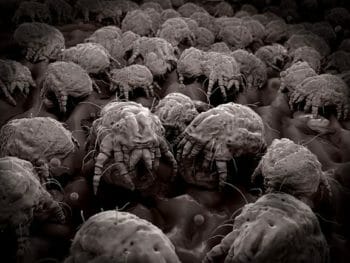The thought of creepy, crawly critters in the bed we find so cozy goes against everything we know. Our bed is our safe place; our ultimate form of relaxation and rejuvenation. And then the mind begins to wonder. Do I have dust mites in my bed?
You do have dust mites in your bed, as dust mites thrive in an environment of moisture and dead skill cells. When you breathe and sweat, humidity is trapped under your covers where dust mites reside. Dust mites are also found on pillows and mattresses. It is recommended to wash your bedding often.

The reality of dust mites is a bit unsettling, to say the least. However, there are things you can do to combat how comfortable the dust mites are in your bed and in your home.
Almost every home has dust mites, regardless of how clean it is.
To be honest, I’m happy that we cannot see dust mites with our bare eyes, as we would never want to sit on your furniture or climb into our bed ever again.
Do I Have Dust Mites in My Bed?
You dust, you vacuum, and you mop. So it’s a fair question. Do I have dust mites in my bed?
Yes, you do have dust mites in your bed. Virtually everyone has at least some amount of dust mites in their beds, regardless of how clean they are.
These lovely little pests are feeding on your dead skin cells and flourish in your warm humidity at night.
Our sweat and our breath when we sleep combined with our dead skin cells that continually shed make our beds one of the more common places for dust mites.
As much as we don’t want to think about it, our pillows are one of the best breeding grounds for dust mites.
The heat and moisture from our faces nestled into our pillows when we sleep is heaven for these little critters.
Especially since we all drool at times, and many of us breathe through our mouths when we sleep. It doesn’t get any more perfect from a dust mite’s point of view.
What is an Energy Recovery Ventilator (ERV)? Ultimate Resource Learn how an energy recovery ventilator helps capture indoor humidity, odors, and pollutants such as chemicals, pollen, and smoke particles.
When we rustle around in our beds, dust mites feces and body parts become airborne and are one of the most popular airborne allergens in the home.
So not only are you sleeping with dust mites, you are breathing their allergens right up close and personal.
Be happy you can’t see them with the naked eye, or you would never climb into your bed again.
A bit further in this article, we will go over things you can do to reduce and even kill dust mites.
How Many Dust Mites are in My Bed?
Now that we know almost every bed has some amount of dust mites regardless of how clean we are, it begs the question. How many dust mites are in my bed?
There are on average 10,000 to 10 million dust mites living in your bed. Your pillow alone may have millions of dust mites and up to 16 different species. A pillow two years old weighs about 10% more due to dead dust mites and their feces. While sleeping, you are breathing in these dust mite allergens.
I am about to show you what is going on in your bed. After you see this photo, I’m sure you will be just as disgusted as I was. Yes, it’s really true.

As put off as you might be by these invasive little pests, they are typically not harmful to most people. They do not bite and they do not carry diseases.
Dust mite body parts and feces make up a significant amount of the dust in our homes.
Related Article: Dust mite carcasses and feces are significant contributors to the dust in our homes. It’s true folks. Does Dust Come Out of Air Vents? What You Need to Know
When we walk on our carpets, sit on our furniture, or toss and turn in our beds, we stir up dust mite allergens.
When dust mite allergens are airborne, we breathe in these particles. For most of us, these allergens may cause a mild reaction, and for some more serious.
Common Reactions to Dust Mite Allergens:
- Sneezing
- Sore throat
- Wheezing
- Coughing
Those suffering from asthma are more sensitive to dust mite allergens and may experience serious asthma attacks.
How Do I Get Rid of Dust Mites on My Bed?
If you are like me you are wondering what you can do to take some control and reduce the existence of these tiny organisms in your bed.
How Do I Get Rid of Dust Mites on My Bed?
1. Buy a new bed set and start fresh.
2. Use a dust-mite-proof mattress cover.
3. Buy a new pillow.
4. Use a dust-mite-proof pillow cover.
5. Wash bedding weekly in hot water.
6. Toss your pillow into a hot dryer.
7. Use a dehumidifier in your bedroom.
Purchasing a new mattress is a pricey proposition, but if you can afford it and you are serious about making a fresh start and tackling these critters, it’s the ultimate first step.
For those who need to take a more practical approach, let’s go over some things you can do to feel more empowered.
Use boxspring and mattress covers specifically made to keep out dust mites and other allergens. Ideally, even these should be removed and cleaned every week.
Now granted, mattresses and box springs can be large and a bit cumbersome to remove the covers from and then put them back on after being washed.
A more practical rule of thumb could be to do this monthly and with an extra hand to help you.
Now let’s go over that pillow of yours; the pillow that you nuzzle your face up against at night and often drool on.
The moisture and heat that you generate on your pillow when sleeping are what dust mites love.
You may want to start fresh with a new pillow. At the very least, make sure to wash your pillow a few times per year, checking the care label on the pillow for the best results.
One of the best things you are doing in your home and in your bedroom to keep dust mites at bay is to purchase a dehumidifier.
Dust mites thrive in a humid environment while absorbing the moisture from the air into their bodies.
By reducing the humidity in your home to suggested levels between 30 – 50%, you are substantially reducing the comfort level of the dust mites, killing them.
Not every dehumidifier is created equal, so you will naturally want to do your research to ensure you are getting the best dehumidifier for the amount of money you can afford.
After you learn about the features that you want, your next step should be to read the reviews on each product and not settle for anything less than a 4.5-star rating.
Related Article: 11 Ways to Get Rid of Dust in Your House
Will Putting My Pillow in the Dryer Kill Dust Mites?
Pillows are a top nesting ground for dust mites. The heat and moisture provided to them when they sleep are ideal for their survival. Will putting your pillow in the dryer kill dust mites?
Putting your pillow in the dryer at a temperature of 130 degrees or higher will kill dust mites. Even if it is recommended not to wash your pillow, all pillows may still be put in the dryer. A hot dryer will likely kill dust mites, but a dryer will not remove the dust mite allergens.
It may be best to take your pillows to a Laundromat and use their large capacity machines for better cleaning.
Pillow covers used underneath your pillowcase are recommended, as well as using two pillowcases.
We all drool at night, so the top pillowcase acts as a drool-catcher while the second pillowcase underneath acts as a second barrier.
Hypoallergenic pillow covers can be beneficial in keeping dust mites from getting into your pillow.
Plastic, vinyl, or woven pillow covers are recommended for the best protection.
Tightly woven pillow covers have been shown to be very effective at keeping dust mites from getting to your pillow as well as being more comfortable.
Can Dust Mites Live in Memory Foam?
Whether you have a memory foam mattress or are considering one, you surely have questions. Can dust mites live in memory foam?
Dust mites cannot live in memory foam, as memory foam is too dense for dust mites to penetrate the dense foam. Non-washable memory foam will still accumulate dust mites and dust mite allergens on the surface. Using a dust mite cover will help keep your memory foam clean from dust mites.
There are different types of memory foam, but regardless of what kind you have or decide to purchase, you are on the right track to protecting yourself from dust mites.

Trina Greenfield, Author
SmackDown Media LLC
LinkedIn
About the Author:
Trina Greenfield, the owner of SmackDown Media LLC, is passionate about providing information to those interested in the air quality in and around their homes. Trina writes content about things she’s passionate about, such as safe, in-home air, educational platforms for children and adults, as well as all things family-related.
